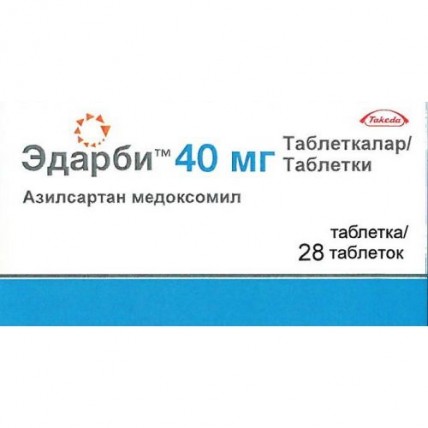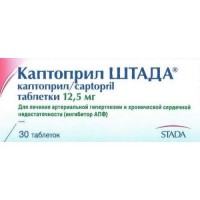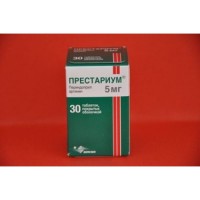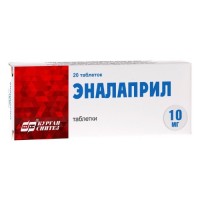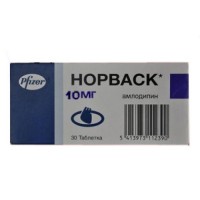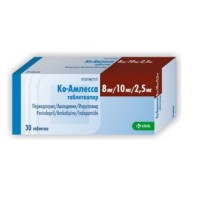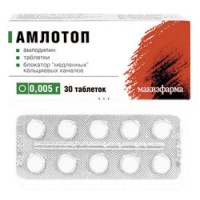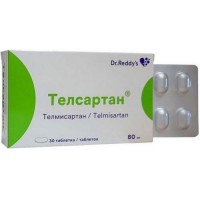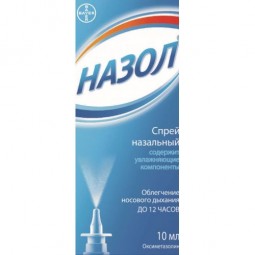Edarbi 40 mg (28 tablets)
- $24.10
The instruction for medical use
of Edarbi Torgovoye medicine the name
of Edarbi
the International unlicensed
name Azilsartan was medoksomit
the Dosage form
of the Tablet of 40 mg and 80 mg
by Structure
One tablet, contains
active agent - azilsartan a medoksomila of potassium of 42.68 mg and 85.36 mg (it is equivalent azilsartan to a medoksomil of 40 mg and 80 mg),
excipients: Mannitolum, fumaric acid, sodium hydroxide, hydroxypropyl cellulose, sodium of a kroskarmelloz, cellulose microcrystalline, magnesium stearate.
The description
of the Tablet of 40 mg
of the Tablet of a flat form from white till almost white color with the squeezed-out inscription ASL on one party and the squeezed-out figure 40 on other party. Diameter of a tablet is about 7.6 mm, thickness is about 4.2 mm.
Tablets of 80 mg
of the Tablet of a flat form from white till almost white color with the squeezed-out inscription ASL on one party and the squeezed-out figure 80 on other party. Diameter of a tablet is about 9.6 mm, thickness is about 5.3 mm.
Pharmacotherapeutic group
the Drugs vliyushchy on renin-angiotenzinovuyu a system. Antagonists of angiotensin II. Azilsartan medoksomit.
The ATX C09CA09 code
azilsartan medoksomit the Pharmacological Pharmacokinetics Later properties of oral administration quickly is hydrolyzed to an active azilsartan in digestive tract and/or during absorption. The researches in vitro showed that the karboksimetilenbutenolidaza participates in hydrolysis in intestines and a liver. Besides, esterases of plasma participate in hydrolysis azilsartan a medoksomila in azilsartan.
Absorption
the Expected absolute bioavailability azilsartan a medoksomila on the basis of concentration of an azilsartan in plasma is about 60%. After oral administration azilsartan medoksomit peak concentration (Cmax) of an azilsartan in plasma are reached within 1.5-3 hours. Food does not affect bioavailability of an azilsartan.
Distribution
the Volume of distribution of an azilsartan makes about 16 liters. Azilsartan almost completely contacts proteins of plasma (& gt, 99%), generally seralbumin. At the concentration of an azilsartan in plasma considerably exceeding the range reached at the recommended doses the steady linking with proteins is observed.
Metabolism
Azilsartan is metabolized to two main metabolites. The main metabolite in plasma is formed by O-dealkylation and is called a metabolite of M-II, other metabolite of M-I is formed in smaller concentration by decarboxylation. Systemic action of both metabolites in a human body makes about 50% and less than 1% respectively. M-I and M-II do not participate in pharmacological activity of Edarbi. The main enzyme which is responsible for metabolism of an azilsartan is CYP2C9.
14C-marked azilsartan medoksomit removal After intake of a dose, about 55% of radioactivity are shown to Calais and about 42% in urine, 15% of this dose are excreted with urine in the form of an azilsartan. Elimination half-life of an azilsartan makes about 11 hours, the renal clearance is about 2.3 ml/min. Constant concentration of an azilsartan is reached within 5 days and at repeated receptions once a day cumulation in plasma does not happen.
Linearity/nonlinearity of doses
Proportionality of a dose in exposure is established for an azilsartan in a dose azilsartan a medoksomila from 20 mg to 320 mg after single or multiple dose.
Special groups of patients
Elderly patients (65 years are also more senior)
Pharmacokinetics of an azilsartan at young people (age of 18-45 years) and elderly (age of 65-85 years) patients significantly do not differ.
The renal failure
of Any increase (+5%) in exposure at patients with an end-stage of a disease of the kidneys needing a hemodialysis was not observed. Nevertheless, patients have no clinical experience of reception with a renal failure of heavy degree and an end-stage of a disease of kidneys. The hemodialysis does not delete azilsartan from a system blood-groove.
The abnormal liver function
of Naznacheniye Edarbi for a period of up to 5 days at patients with abnormal liver functions easy (class A on a scale of Chayld-Pyyu) or moderated (class B on a scale of Chayld-Pyyu) led degrees to insignificant increase in influence of an azilsartan (AUC increased by 1,3 1,6 times). Edarb at patients with abnormal liver functions of heavy degree it was not studied.
Paul Pharmakokinetika of an azilsartan at men and women significantly does not differ.
A pharmacodynamics
Azilsartan medoksomit is oral active pro-medicine which quickly turns into an active azilsartan, being the selection antagonist of angiotensin II, by blocking of its linking with receptors of the angiotensin of type 1 (AT1) in various fabrics. Angiotensin II is the main pressor substance system renin-angiotenzinovoy with the effects including vasoconstriction, stimulation of synthesis and release of Aldosteronum, stimulation of warm activity and a renal reabsorption of sodium.
Blockade of AT1 of receptors leads to oppression of negative return impact of angiotensin II on renin secretion, but the subsequent increase in activity of the circulating levels of renin of plasma and angiotensin II does not weaken clinical antihypertensive effect of an azilsartan.
At use of Edarbi in treatment of arterial hypertension typical dynamics of the arterial blood pressure (ABP) is as follows:
- average daily systolic arterial blood pressure decreases by 13.4 13.5 mm Hg. at reception of 40 mg, on 14.5 14.6 mm Hg. at reception of 80 mg,
- office systolic arterial blood pressure decreases by 14.5 16.4 mm Hg. at reception of 40 mg, on 16.7 17.6 mm Hg. at reception of 80 mg.
The hypotensive effect of Edarbi is maintained for 24 hours after reception.
Ricochet hypertensia after cancellation of therapy of Edarbi is not observed.
Co-administration of Edarbi of 40 and 80 mg with blockers of calcium channels (amlodipin) or thiazide diuretic led (Chlortalidonum) to additional decrease in the ABP in comparison with other antihypertensive drugs as monotherapy. Dose-dependent side effects, including dizziness, arterial hypotension and increase in level of serumal creatinine, were more often observed at co-administration of diuretics in comparison with reception of Edarbi as monotherapy, and the hypopotassemia was observed less often in comparison with monotherapy by diuretic.
Influence on warm repolarization
At reception of Edarbi in a dose up to 320 mg a day of any signs of lengthening of intervals of QT/QTc was not.
Indications
- treatment of essential arterial hypertension at adults
the Route of administration and doses
of the Tablet should be accepted inside regardless of meal.
The recommended initial dose makes 40 mg once a day. The dose can be increased to the maximum dose of 80 mg once a day at patients whose ABP at lower doses properly is not controlled.
The clinical antihypertensive effect is shown on the 2nd week, and the maximum effect is reached by 4th week of reception.
If the ABP properly is not controlled by means of monotherapy of Edarbi, then additional decrease in the ABP can be reached at co-administration of Edarbi with other antihypertensive drugs, including diuretics (such as Chlortalidonum and hydrochlorothiazide) and blockers of calcium channels (such as amlodipin).
Special groups of patients
Elderly patients (65 years are also more senior)
elderly patients have no need in special selection of a dose of Edarbi, however for patients 75 years with risk of developing of arterial hypotension are more senior it is necessary to consider the possibility of use of drug in a dose of 20 mg as an initial dose.
A renal failure
It is necessary to be careful at patients with a renal failure of heavy degree and an end-stage of a disease of kidneys as such patients have no experience of use of Edarbi.
The hemodialysis does not delete azilsartan from blood circulation.
Dose adjustment with renal failures easy and moderate severity is not required from patients.
The abnormal liver function
At patients with a heavy liver failure of a research on use of Edarbi was not carried out therefore drug is not recommended to be used in this group of patients.
As experience of use of Edarbi at patients with abnormal liver functions of easy and average degree is limited, careful observation of such patients is recommended.
Deficit of intravascular volume
At patients with possible deficit of intravascular volume or salt exhaustion (for example, patients with vomiting, diarrhea or the accepting high doses of diuretics), reception of Edarbi it is necessary to begin under careful medical observation, it is also necessary to consider the possibility of use of Edarbi in an initial dose of 20 mg.
Heart failure
It is necessary to be careful at hypertensive patients with stagnant heart failure as such patients have no experience of use of Edarbi.
Side effects
At reception of Edarbi side effects can be lungs or moderate severity.
Gender and age do not influence the frequency of manifestation of side effects.
Frequency of side effects of drug is regarded as follows:
Very frequent: 1/10
Frequent: 1/100, & lt, 1/10
Infrequent: 1/1000, & lt, 1/100
Rare: 1/10,000, & lt, 1/1000
Very rare: & lt, 1/10,000
is frequent
- dizziness
- diarrhea
- increase in a kreatinfosfokinaza of blood
Infrequently
- arterial hypotension
- nausea
- rash, an itching
- muscular spasms
- feeling of fatigue
- peripheral swell
- increase in level of creatinine of blood
- increase in concentration of uric acid in a blood / hyperuricemia
Is rare
- a Quincke's disease
the Description of separate side reactions
At simultaneous use of Edarbi with Chlortalidonum the frequency of increase in level of creatinine of blood and hypotension increased from infrequent to frequent.
At simultaneous use of Edarbi with amlodipiny the frequency of peripheral hypostases increased, but was lower, than at use of an amlodipin in monotherapy.
Frequency of increases in level of creatinine in blood serum after use of monotherapy of Edarbi was similar to placebo in randomized placebos - controlled researches. Also as well as at use of other antagonists of receptors of angiotensin II and inhibitors of angiotensin-converting enzyme (APF inhibitors), simultaneous use of the drug Edarbi with diuretics (for example, Chlortalidonum) leads to increase of cases of increase in concentration of creatinine. Increase in concentration of creatinine at simultaneous use of Edarbi is connected with diuretics with бó, lshy decrease in the ABP in comparison with monotherapy of Edarbi. The majority of these effects were short-term or not progressing while patients continued therapy. After drug withdrawal the majority of the cases of increase in concentration of creatinine which were not passing during treatment were reversible. Concentration of creatinine at most of patients returned to basic or to almost basic values.
During the researches with Edarbi the small increase in concentration of uric acid in blood serum (10.8 µmol/l) in comparison with placebo (4.3 µmol/l) was also observed.
During placebo - controlled researches with Edarbi the small decrease in hemoglobin and a hematocrit was noted (on 3 g/l and 1 percent by volume respectively). This effect was also observed at use of other inhibitors the system renin-angiotensin-aldosteronovoy (SRAA).
The contraindication
- hypersensitivity to active agent or to any of excipients
- combined use of Edarbi with aliskireny at patients with diabetes or renal failures (the glomerular filtration rate (GFR) & lt, 60 ml/min. / 1.73 sq.m)
- an abnormal liver function of heavy degree
- pregnancy and the period of a lactation
- children's and teenage age up to 18 years
Medicinal interactions
is not recommended simultaneous use
of Lities
At simultaneous use of lithium and APF inhibitors the reversible increase in concentration of lithium in blood serum and reversible increase in expressiveness of manifestations of toxicity is registered. The similar effect can arise also with antagonists of receptors of angiotensin II. Due to the lack of experience of simultaneous use azilsartan medoksomit also a lity, this combination is not recommended. If this combination was necessary, then careful monitoring of level of serumal lithium is recommended.
The care at simultaneous use is required
Non-steroidal anti-inflammatory drugs (NPVP), including selection inhibitors of cyclooxygenase-2 (TsOG-2), acetylsalicylic acid & gt, 3 g a day and non-selective NPVP
At a concomitant use of antagonists of receptors of angiotensin II can happen to NPVP decrease in antihypertensive effect. Besides, simultaneous use of antagonists of receptors of angiotensin II and NPVP can result in the increased risk of deterioration in function of kidneys and increase in potassium in blood serum. Therefore in an initiation of treatment the adequate hydration and monitoring of renal functions is recommended.
Kaliysberegayushchy diuretic,
can lead potassium drugs, the salt substitutes containing potassium, and other substances which can increase potassium concentrations Simultaneous use of kaliysberegayushchy diuretics of drugs of potassium, substitutes of salt containing potassium or other medicines (for example, heparin) to increase in potassium concentration. As required it is necessary to carry out monitoring of potassium in blood serum.
Additional information
of Any clinically significant interactions azilsartan the medoksomil or an azilsartan with amlodipiny, antacids, Chlortalidonum, digoxin, flukonazoly, glibenclamide, ketokonazoly, metformin and warfarin was not registered.
Azilsartan medoksomit quickly is hydrolyzed to an active azilsartan by esterases in digestive tract and/or at drug absorption. The researches in vitro showed that interactions on the basis of inhibition of esterases are improbable.
The special
instructions Activated renin-angiotensin-aldosteronovaya a system
At patients, a vascular tone and which function of kidneys depend mainly on activity of RAAS (for example, at patients with stagnant heart failure, heavy renal failures or a renal artery stenosis), treatment by APF inhibitors and antagonists of angiotensin II it was connected with acute arterial hypotension, an azotemia, an oliguria or, it is rare with an acute renal failure. Probability of similar effects cannot be excluded at Edarbi.
It is necessary to be careful at patients with heavy renal failures, stagnant heart failure or a renal artery stenosis as these patients have no experience of use of Edarbi.
Excessive decrease in the ABP at patients with an ischemic cardiomyopathy or an ischemic cerebrovascular disease can lead to a myocardial infarction or a stroke.
Double blockade system renin-angiotensin-aldosteronovoy
Double blockade of RAAS blockers of receptors of angiotensin, APF inhibitors, or aliskireny is connected with increase in risk of developing of arterial hypotension, a hyperpotassemia and change of function of kidneys (including, an acute renal failure) in comparison with monotherapy. It is necessary to control attentively the ABP, function of kidneys and level of electrolytes at the patients accepting Edarbi and other medicines influencing RAAS.
Transplantation of kidneys
Now the patients who recently transferred transplantation of kidneys have no experience of use of Edarbi.
An abnormal liver function
At patients with a heavy liver failure of Edarbi it was not studied and therefore it is not recommended to use it in this group of patients.
Hypotension at patients with water or salt exhaustion
At patients with the significant decrease in volume of the circulating blood and/or salt exhaustion (for example, at patients with vomiting, diarrhea or the diuretics accepting high doses) after an initiation of treatment of Edarbi can arise symptomatic arterial hypotension. The hypovolemia should be modified before reception of Edarbi, or treatment should be begun under careful medical observation. Also it is necessary to consider the possibility of purpose of an initial dose of 20 mg.
Primary hyper aldosteronism
Patients with primary hyper aldosteronism usually do not react to the antihypertensive drugs operating by inhibition system renin-angiotenzinovoy. Thus, use of Edarbi at these patients is not recommended.
The hyperpotassemia
on the basis of experience of use of other medicines influencing renin-angiotensin-aldosteronovuyu a system, simultaneous use of Edarbi with kaliysberegayushchy diuretics, kaliysoderzhashchy additives, the salt substitutes containing potassium or other medicines which are capable to increase potassium level (for example heparin) can lead to increase in potassium in blood of patients with AG.
At elderly people, at patients with a renal failure, at patients with diabetes and/or at patients with other associated diseases the risk of a hyperpotassemia which can be fatal increases. As required it is necessary to control potassium level.
The stenosis of aortal and mitral valves, a subaortic hypertrophic stenosis
Are recommended special precautionary measures at patients with a stenosis of aortal or mitral valves and also with a hypertrophic subaortic stenosis (GOKM).
Pregnancy and the period of a lactation
Data on use of Edarbi for pregnant women are absent. Researches on animals revealed reproductive toxicity. At approach or planning of pregnancy it is necessary to stop immediately use of drug and, if necessary, to pass to alternative therapy.
As there is no information on use of Edarbi during breastfeeding, use of Edarbi is not recommended, and alternative methods of treatment with the best proved characteristics of safety are more preferable during feeding by a breast, especially during feeding of the newborn or premature child.
It is expected features of influence of medicine on ability to run the vehicle or potentially dangerous mechanisms on the basis of pharmakodinamichesky properties that azilsartan medoksomit has insignificant influence on ability to drive the car and work with mechanisms. Nevertheless, at intake of any
antihypertensive drugs it is necessary to consider that there can sometimes come dizziness or feeling of fatigue.
Overdose
At the patients accepting 320 mg of Edarbi a day within 7 days, signs of overdose were not noted.
Symptoms: arterial hypotension and dizziness.
Treatment: if there was arterial hypotension, then it is necessary to begin symptomatic therapy and to carry out monitoring of the vital functions. The hemodialysis is not effective.
The form of release and packing
On 14 tablets place in blister strip packaging from the form-building aluminum material covered from the inside with a polyethylene layer with the calcium oxide applied from above as the drying-up layer. From above packing is closed by the laminated aluminum foil with the polyethylene layer put from within.
On 2 planimetric packs (for a dosage of 40 mg) or on 2 or 4 planimetric packs (for a dosage of 80 mg) together with the instruction for medical use in the state and Russian languages put in a pack cardboard.
Storage conditions
At
a temperature not higher than 25 S. Hranit out of children's reach!
A period of storage
3 years
not to use drug after expiry date
Prescription status
According to the prescription
of Proizvoditel Takeda Pharmaceutical Company of Ltd., Osaka Plante, Japan
the Packer and
Takeda releasing quality control Ayland of Ltd., Ireland
the Owner of the registration certificate
Takeda of Pharm of A/S, Denmark
the Address of the organization accepting in the territory of the Republic of Kazakhstan claims from consumers on quality of products (goods)
Representative office Takeda Osteuropa Holding GmbH (Austria) in Kazakhstan: 050010 Almaty, Begalin St. 136 and
Ph. +7 (727) 2444 004
Fax +7 (727) 2444 005
To develop the e-mail address of DSO-KZ@takeda.com
of Edarbi Torgovoye medicine the name
of Edarbi
the International unlicensed
name Azilsartan was medoksomit
the Dosage form
of the Tablet of 40 mg and 80 mg
by Structure
One tablet, contains
active agent - azilsartan a medoksomila of potassium of 42.68 mg and 85.36 mg (it is equivalent azilsartan to a medoksomil of 40 mg and 80 mg),
excipients: Mannitolum, fumaric acid, sodium hydroxide, hydroxypropyl cellulose, sodium of a kroskarmelloz, cellulose microcrystalline, magnesium stearate.
The description
of the Tablet of 40 mg
of the Tablet of a flat form from white till almost white color with the squeezed-out inscription ASL on one party and the squeezed-out figure 40 on other party. Diameter of a tablet is about 7.6 mm, thickness is about 4.2 mm.
Tablets of 80 mg
of the Tablet of a flat form from white till almost white color with the squeezed-out inscription ASL on one party and the squeezed-out figure 80 on other party. Diameter of a tablet is about 9.6 mm, thickness is about 5.3 mm.
Pharmacotherapeutic group
the Drugs vliyushchy on renin-angiotenzinovuyu a system. Antagonists of angiotensin II. Azilsartan medoksomit.
The ATX C09CA09 code
azilsartan medoksomit the Pharmacological Pharmacokinetics Later properties of oral administration quickly is hydrolyzed to an active azilsartan in digestive tract and/or during absorption. The researches in vitro showed that the karboksimetilenbutenolidaza participates in hydrolysis in intestines and a liver. Besides, esterases of plasma participate in hydrolysis azilsartan a medoksomila in azilsartan.
Absorption
the Expected absolute bioavailability azilsartan a medoksomila on the basis of concentration of an azilsartan in plasma is about 60%. After oral administration azilsartan medoksomit peak concentration (Cmax) of an azilsartan in plasma are reached within 1.5-3 hours. Food does not affect bioavailability of an azilsartan.
Distribution
the Volume of distribution of an azilsartan makes about 16 liters. Azilsartan almost completely contacts proteins of plasma (& gt, 99%), generally seralbumin. At the concentration of an azilsartan in plasma considerably exceeding the range reached at the recommended doses the steady linking with proteins is observed.
Metabolism
Azilsartan is metabolized to two main metabolites. The main metabolite in plasma is formed by O-dealkylation and is called a metabolite of M-II, other metabolite of M-I is formed in smaller concentration by decarboxylation. Systemic action of both metabolites in a human body makes about 50% and less than 1% respectively. M-I and M-II do not participate in pharmacological activity of Edarbi. The main enzyme which is responsible for metabolism of an azilsartan is CYP2C9.
14C-marked azilsartan medoksomit removal After intake of a dose, about 55% of radioactivity are shown to Calais and about 42% in urine, 15% of this dose are excreted with urine in the form of an azilsartan. Elimination half-life of an azilsartan makes about 11 hours, the renal clearance is about 2.3 ml/min. Constant concentration of an azilsartan is reached within 5 days and at repeated receptions once a day cumulation in plasma does not happen.
Linearity/nonlinearity of doses
Proportionality of a dose in exposure is established for an azilsartan in a dose azilsartan a medoksomila from 20 mg to 320 mg after single or multiple dose.
Special groups of patients
Elderly patients (65 years are also more senior)
Pharmacokinetics of an azilsartan at young people (age of 18-45 years) and elderly (age of 65-85 years) patients significantly do not differ.
The renal failure
of Any increase (+5%) in exposure at patients with an end-stage of a disease of the kidneys needing a hemodialysis was not observed. Nevertheless, patients have no clinical experience of reception with a renal failure of heavy degree and an end-stage of a disease of kidneys. The hemodialysis does not delete azilsartan from a system blood-groove.
The abnormal liver function
of Naznacheniye Edarbi for a period of up to 5 days at patients with abnormal liver functions easy (class A on a scale of Chayld-Pyyu) or moderated (class B on a scale of Chayld-Pyyu) led degrees to insignificant increase in influence of an azilsartan (AUC increased by 1,3 1,6 times). Edarb at patients with abnormal liver functions of heavy degree it was not studied.
Paul Pharmakokinetika of an azilsartan at men and women significantly does not differ.
A pharmacodynamics
Azilsartan medoksomit is oral active pro-medicine which quickly turns into an active azilsartan, being the selection antagonist of angiotensin II, by blocking of its linking with receptors of the angiotensin of type 1 (AT1) in various fabrics. Angiotensin II is the main pressor substance system renin-angiotenzinovoy with the effects including vasoconstriction, stimulation of synthesis and release of Aldosteronum, stimulation of warm activity and a renal reabsorption of sodium.
Blockade of AT1 of receptors leads to oppression of negative return impact of angiotensin II on renin secretion, but the subsequent increase in activity of the circulating levels of renin of plasma and angiotensin II does not weaken clinical antihypertensive effect of an azilsartan.
At use of Edarbi in treatment of arterial hypertension typical dynamics of the arterial blood pressure (ABP) is as follows:
- average daily systolic arterial blood pressure decreases by 13.4 13.5 mm Hg. at reception of 40 mg, on 14.5 14.6 mm Hg. at reception of 80 mg,
- office systolic arterial blood pressure decreases by 14.5 16.4 mm Hg. at reception of 40 mg, on 16.7 17.6 mm Hg. at reception of 80 mg.
The hypotensive effect of Edarbi is maintained for 24 hours after reception.
Ricochet hypertensia after cancellation of therapy of Edarbi is not observed.
Co-administration of Edarbi of 40 and 80 mg with blockers of calcium channels (amlodipin) or thiazide diuretic led (Chlortalidonum) to additional decrease in the ABP in comparison with other antihypertensive drugs as monotherapy. Dose-dependent side effects, including dizziness, arterial hypotension and increase in level of serumal creatinine, were more often observed at co-administration of diuretics in comparison with reception of Edarbi as monotherapy, and the hypopotassemia was observed less often in comparison with monotherapy by diuretic.
Influence on warm repolarization
At reception of Edarbi in a dose up to 320 mg a day of any signs of lengthening of intervals of QT/QTc was not.
Indications
- treatment of essential arterial hypertension at adults
the Route of administration and doses
of the Tablet should be accepted inside regardless of meal.
The recommended initial dose makes 40 mg once a day. The dose can be increased to the maximum dose of 80 mg once a day at patients whose ABP at lower doses properly is not controlled.
The clinical antihypertensive effect is shown on the 2nd week, and the maximum effect is reached by 4th week of reception.
If the ABP properly is not controlled by means of monotherapy of Edarbi, then additional decrease in the ABP can be reached at co-administration of Edarbi with other antihypertensive drugs, including diuretics (such as Chlortalidonum and hydrochlorothiazide) and blockers of calcium channels (such as amlodipin).
Special groups of patients
Elderly patients (65 years are also more senior)
elderly patients have no need in special selection of a dose of Edarbi, however for patients 75 years with risk of developing of arterial hypotension are more senior it is necessary to consider the possibility of use of drug in a dose of 20 mg as an initial dose.
A renal failure
It is necessary to be careful at patients with a renal failure of heavy degree and an end-stage of a disease of kidneys as such patients have no experience of use of Edarbi.
The hemodialysis does not delete azilsartan from blood circulation.
Dose adjustment with renal failures easy and moderate severity is not required from patients.
The abnormal liver function
At patients with a heavy liver failure of a research on use of Edarbi was not carried out therefore drug is not recommended to be used in this group of patients.
As experience of use of Edarbi at patients with abnormal liver functions of easy and average degree is limited, careful observation of such patients is recommended.
Deficit of intravascular volume
At patients with possible deficit of intravascular volume or salt exhaustion (for example, patients with vomiting, diarrhea or the accepting high doses of diuretics), reception of Edarbi it is necessary to begin under careful medical observation, it is also necessary to consider the possibility of use of Edarbi in an initial dose of 20 mg.
Heart failure
It is necessary to be careful at hypertensive patients with stagnant heart failure as such patients have no experience of use of Edarbi.
Side effects
At reception of Edarbi side effects can be lungs or moderate severity.
Gender and age do not influence the frequency of manifestation of side effects.
Frequency of side effects of drug is regarded as follows:
Very frequent: 1/10
Frequent: 1/100, & lt, 1/10
Infrequent: 1/1000, & lt, 1/100
Rare: 1/10,000, & lt, 1/1000
Very rare: & lt, 1/10,000
is frequent
- dizziness
- diarrhea
- increase in a kreatinfosfokinaza of blood
Infrequently
- arterial hypotension
- nausea
- rash, an itching
- muscular spasms
- feeling of fatigue
- peripheral swell
- increase in level of creatinine of blood
- increase in concentration of uric acid in a blood / hyperuricemia
Is rare
- a Quincke's disease
the Description of separate side reactions
At simultaneous use of Edarbi with Chlortalidonum the frequency of increase in level of creatinine of blood and hypotension increased from infrequent to frequent.
At simultaneous use of Edarbi with amlodipiny the frequency of peripheral hypostases increased, but was lower, than at use of an amlodipin in monotherapy.
Frequency of increases in level of creatinine in blood serum after use of monotherapy of Edarbi was similar to placebo in randomized placebos - controlled researches. Also as well as at use of other antagonists of receptors of angiotensin II and inhibitors of angiotensin-converting enzyme (APF inhibitors), simultaneous use of the drug Edarbi with diuretics (for example, Chlortalidonum) leads to increase of cases of increase in concentration of creatinine. Increase in concentration of creatinine at simultaneous use of Edarbi is connected with diuretics with бó, lshy decrease in the ABP in comparison with monotherapy of Edarbi. The majority of these effects were short-term or not progressing while patients continued therapy. After drug withdrawal the majority of the cases of increase in concentration of creatinine which were not passing during treatment were reversible. Concentration of creatinine at most of patients returned to basic or to almost basic values.
During the researches with Edarbi the small increase in concentration of uric acid in blood serum (10.8 µmol/l) in comparison with placebo (4.3 µmol/l) was also observed.
During placebo - controlled researches with Edarbi the small decrease in hemoglobin and a hematocrit was noted (on 3 g/l and 1 percent by volume respectively). This effect was also observed at use of other inhibitors the system renin-angiotensin-aldosteronovoy (SRAA).
The contraindication
- hypersensitivity to active agent or to any of excipients
- combined use of Edarbi with aliskireny at patients with diabetes or renal failures (the glomerular filtration rate (GFR) & lt, 60 ml/min. / 1.73 sq.m)
- an abnormal liver function of heavy degree
- pregnancy and the period of a lactation
- children's and teenage age up to 18 years
Medicinal interactions
is not recommended simultaneous use
of Lities
At simultaneous use of lithium and APF inhibitors the reversible increase in concentration of lithium in blood serum and reversible increase in expressiveness of manifestations of toxicity is registered. The similar effect can arise also with antagonists of receptors of angiotensin II. Due to the lack of experience of simultaneous use azilsartan medoksomit also a lity, this combination is not recommended. If this combination was necessary, then careful monitoring of level of serumal lithium is recommended.
The care at simultaneous use is required
Non-steroidal anti-inflammatory drugs (NPVP), including selection inhibitors of cyclooxygenase-2 (TsOG-2), acetylsalicylic acid & gt, 3 g a day and non-selective NPVP
At a concomitant use of antagonists of receptors of angiotensin II can happen to NPVP decrease in antihypertensive effect. Besides, simultaneous use of antagonists of receptors of angiotensin II and NPVP can result in the increased risk of deterioration in function of kidneys and increase in potassium in blood serum. Therefore in an initiation of treatment the adequate hydration and monitoring of renal functions is recommended.
Kaliysberegayushchy diuretic,
can lead potassium drugs, the salt substitutes containing potassium, and other substances which can increase potassium concentrations Simultaneous use of kaliysberegayushchy diuretics of drugs of potassium, substitutes of salt containing potassium or other medicines (for example, heparin) to increase in potassium concentration. As required it is necessary to carry out monitoring of potassium in blood serum.
Additional information
of Any clinically significant interactions azilsartan the medoksomil or an azilsartan with amlodipiny, antacids, Chlortalidonum, digoxin, flukonazoly, glibenclamide, ketokonazoly, metformin and warfarin was not registered.
Azilsartan medoksomit quickly is hydrolyzed to an active azilsartan by esterases in digestive tract and/or at drug absorption. The researches in vitro showed that interactions on the basis of inhibition of esterases are improbable.
The special
instructions Activated renin-angiotensin-aldosteronovaya a system
At patients, a vascular tone and which function of kidneys depend mainly on activity of RAAS (for example, at patients with stagnant heart failure, heavy renal failures or a renal artery stenosis), treatment by APF inhibitors and antagonists of angiotensin II it was connected with acute arterial hypotension, an azotemia, an oliguria or, it is rare with an acute renal failure. Probability of similar effects cannot be excluded at Edarbi.
It is necessary to be careful at patients with heavy renal failures, stagnant heart failure or a renal artery stenosis as these patients have no experience of use of Edarbi.
Excessive decrease in the ABP at patients with an ischemic cardiomyopathy or an ischemic cerebrovascular disease can lead to a myocardial infarction or a stroke.
Double blockade system renin-angiotensin-aldosteronovoy
Double blockade of RAAS blockers of receptors of angiotensin, APF inhibitors, or aliskireny is connected with increase in risk of developing of arterial hypotension, a hyperpotassemia and change of function of kidneys (including, an acute renal failure) in comparison with monotherapy. It is necessary to control attentively the ABP, function of kidneys and level of electrolytes at the patients accepting Edarbi and other medicines influencing RAAS.
Transplantation of kidneys
Now the patients who recently transferred transplantation of kidneys have no experience of use of Edarbi.
An abnormal liver function
At patients with a heavy liver failure of Edarbi it was not studied and therefore it is not recommended to use it in this group of patients.
Hypotension at patients with water or salt exhaustion
At patients with the significant decrease in volume of the circulating blood and/or salt exhaustion (for example, at patients with vomiting, diarrhea or the diuretics accepting high doses) after an initiation of treatment of Edarbi can arise symptomatic arterial hypotension. The hypovolemia should be modified before reception of Edarbi, or treatment should be begun under careful medical observation. Also it is necessary to consider the possibility of purpose of an initial dose of 20 mg.
Primary hyper aldosteronism
Patients with primary hyper aldosteronism usually do not react to the antihypertensive drugs operating by inhibition system renin-angiotenzinovoy. Thus, use of Edarbi at these patients is not recommended.
The hyperpotassemia
on the basis of experience of use of other medicines influencing renin-angiotensin-aldosteronovuyu a system, simultaneous use of Edarbi with kaliysberegayushchy diuretics, kaliysoderzhashchy additives, the salt substitutes containing potassium or other medicines which are capable to increase potassium level (for example heparin) can lead to increase in potassium in blood of patients with AG.
At elderly people, at patients with a renal failure, at patients with diabetes and/or at patients with other associated diseases the risk of a hyperpotassemia which can be fatal increases. As required it is necessary to control potassium level.
The stenosis of aortal and mitral valves, a subaortic hypertrophic stenosis
Are recommended special precautionary measures at patients with a stenosis of aortal or mitral valves and also with a hypertrophic subaortic stenosis (GOKM).
Pregnancy and the period of a lactation
Data on use of Edarbi for pregnant women are absent. Researches on animals revealed reproductive toxicity. At approach or planning of pregnancy it is necessary to stop immediately use of drug and, if necessary, to pass to alternative therapy.
As there is no information on use of Edarbi during breastfeeding, use of Edarbi is not recommended, and alternative methods of treatment with the best proved characteristics of safety are more preferable during feeding by a breast, especially during feeding of the newborn or premature child.
It is expected features of influence of medicine on ability to run the vehicle or potentially dangerous mechanisms on the basis of pharmakodinamichesky properties that azilsartan medoksomit has insignificant influence on ability to drive the car and work with mechanisms. Nevertheless, at intake of any
antihypertensive drugs it is necessary to consider that there can sometimes come dizziness or feeling of fatigue.
Overdose
At the patients accepting 320 mg of Edarbi a day within 7 days, signs of overdose were not noted.
Symptoms: arterial hypotension and dizziness.
Treatment: if there was arterial hypotension, then it is necessary to begin symptomatic therapy and to carry out monitoring of the vital functions. The hemodialysis is not effective.
The form of release and packing
On 14 tablets place in blister strip packaging from the form-building aluminum material covered from the inside with a polyethylene layer with the calcium oxide applied from above as the drying-up layer. From above packing is closed by the laminated aluminum foil with the polyethylene layer put from within.
On 2 planimetric packs (for a dosage of 40 mg) or on 2 or 4 planimetric packs (for a dosage of 80 mg) together with the instruction for medical use in the state and Russian languages put in a pack cardboard.
Storage conditions
At
a temperature not higher than 25 S. Hranit out of children's reach!
A period of storage
3 years
not to use drug after expiry date
Prescription status
According to the prescription
of Proizvoditel Takeda Pharmaceutical Company of Ltd., Osaka Plante, Japan
the Packer and
Takeda releasing quality control Ayland of Ltd., Ireland
the Owner of the registration certificate
Takeda of Pharm of A/S, Denmark
the Address of the organization accepting in the territory of the Republic of Kazakhstan claims from consumers on quality of products (goods)
Representative office Takeda Osteuropa Holding GmbH (Austria) in Kazakhstan: 050010 Almaty, Begalin St. 136 and
Ph. +7 (727) 2444 004
Fax +7 (727) 2444 005
To develop the e-mail address of DSO-KZ@takeda.com
